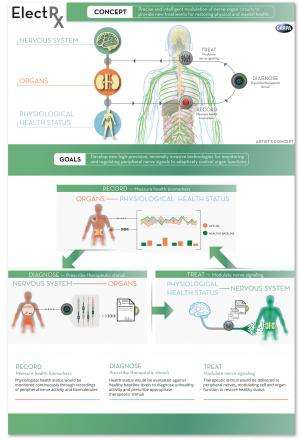ELECTRX has the nerve to envision revolutionary therapies for self-healing

Many chronic inflammatory diseases and mental health conditions affecting military service members and veterans involve abnormal activity in the peripheral nervous system, which plays a key role in organ function. Monitoring and targeted regulation of peripheral nerve signals offer great promise to help patients restore and maintain their health without surgery or drugs. Current neuromodulation devices are typically used as a last resort, however, because they are relatively large (about the size of a deck of cards), require invasive surgical implantation and often produce side effects due to their lack of precision. DARPA's Electrical Prescriptions (ElectRx) program is seeking innovative research proposals to help transform neuromodulation therapies from last resort to first choice for a wide range of diseases.
ElectRx (pronounced "electrics") aims to develop groundbreaking technologies that would use the body's innate neurophysiology to restore and maintain health. In support of the White House's brain initiative, ElectRx also seeks to accelerate understanding of specific neural circuits and their role in health and disease. Future therapies based on targeted peripheral neural stimulation could promote self-healing, reduce dependence on traditional drugs and provide new treatment options for illnesses.
ElectRx would leverage advanced sensing and stimulating technologies to target specific peripheral neural circuits that control organ functions. These feedback-controlled neuromodulation technologies would monitor health status and intervene as needed to deliver patient-specific therapeutic patterns of stimulation designed to restore a healthy physiological state. The program seeks to create ultraminiaturized devices that would require only minimally invasive insertion procedures such as injectable delivery through a needle.
"Many chronic illnesses occur when the body's natural neuroelectrical and biochemical rhythms are disrupted, like playing wrong notes in music," said Doug Weber, DARPA program manager. "ElectRx seeks to understand what the 'right notes' are for each person and provide real-time treatment to help the patient achieve and enjoy a harmonious, healthy baseline. Peripheral neuromodulation therapies based on ElectRx research could help maximize the immunological, physical and mental health of military Service members and veterans."
The scope of ElectRx' research is peripheral neuromodulation treatments for inflammatory diseases (which include rheumatoid arthritis, systemic inflammatory response syndrome and inflammatory bowel disease) and mental health disorders (such as post-traumatic stress disorder (PTSD), anxiety and depression). DARPA expects ElectRx proposers to identify a disease of interest to study and treat. The agency intends to determine overall program success based on advancement of minimally or non-invasive interface technology, the capability to target specific nerves without side effects, validation of biological input/output pathways, and potential for translating this knowledge into an integrated, closed-loop neural-visceral interface for monitoring and maintaining health.
ElectRx plans to explore two principal technical areas:
- Technical Area 1 (TA1): Systems approaches to neurobiological discovery and closed-loop control of physiological status in vivo. Proposals should aim to elucidate the neurobiological foundations of the proposed disease target and use the new insights derived from the physiological studies to drive closed-loop neuromodulation system design and implementation. These efforts should culminate with in vivo demonstrations of predictable and automatic restoration of healthy physiological states in response to on-board physiological state monitoring.
- Technical Area 2 (TA2): Advanced component technology development. Proposals to TA2 should develop and demonstrate in vivo advanced minimally and non-invasive (atraumatic) component technologies, including novel sensing modalities and neural interface technologies. Depending on research results, DARPA may integrate effective technologies developed in both technical areas in a future add-on research phase.
More information: To familiarize potential participants with the technical objectives of ElectRx, DARPA has scheduled a Proposers' Day on Tuesday, December 16, 2014, at the Capitol Conference Center in Arlington, Va. Registration is closed. The DARPA Special Notice document announcing the Proposers' Day and describing the specific capabilities sought is available at go.usa.gov/6zpW. The Broad Agency Announcement with full technical details on ElectRx is available at go.usa.gov/F88T. For more information, please email DARPA-BAA-15-06@darpa.mil.




















